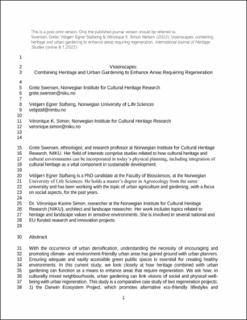Visionscapes: Combining Heritage and Urban Gardening to Enhance Areas Requiring Regeneration
Peer reviewed, Journal article
Accepted version

Åpne
Permanent lenke
https://hdl.handle.net/11250/2989356Utgivelsesdato
2022Metadata
Vis full innførselSamlinger
Originalversjon
10.1080/13527258.2021.2020879Sammendrag
With the occurrence of urban densification, understanding the necessity of encouraging and promoting climate- and environment-friendly urban areas has gained ground with urban planners. Ensuring adequate and easily accessible green public spaces is essential for creating healthy environments. In this current study, we look closely at how heritage combined with urban gardening can function as a means to enhance areas that require regeneration. We ask how, in culturally mixed neighbourhoods, urban gardening can link visions of social and physical well-being with urban regeneration. This study is a comparative case study of two regeneration projects: 1) the Darwin Ecosystem Project, which promotes alternative eco-friendly lifestyles and innovative start-ups through the adaptive reuse of former military barracks in Bordeaux, France; and 2) Dr. Dedichen’s Greenhouse, situated in a heritage environment of a former psychiatric hospital in the eastern part of Oslo, Norway. Conflicting economic, political and cultural views are likely to affect the heritage discourse in marginalised urban areas. When describing heritage in the two neighbourhoods, we used the ‘ruinisation’ approach to ensure an inclusive understanding of heritage. We describe how old buildings, fragments of larger structures adjacent to the remains of recent history, can be integrated into urban planning initiatives as part of larger, active place-remaking processes. Residents, artists and various citizen’s groups, alongside planning authorities, are cooperating to transform neighbourhoods into healthy, climate- and environment-friendly places to live and work. Therefore, heritage combined with urban agriculture is a means to enhance areas that require regeneration.